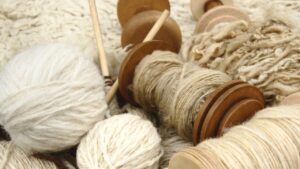If you’ve spotted a moth fluttering near your clothes, you may be facing the early signs of moth damage on clothes. For anyone who has invested in designer garments made from natural fibres like wool, silk or cashmere (even if blended with polyester), moths can pose a serious threat. This guide will show you exactly how to protect designer clothes from moths, prevent long-term damage, and take smart action fast.
What Causes Moth Damage on Clothes?
Clothes moths (Tineola bisselliella) are drawn to keratin, a protein found in animal-based fibres such as wool, cashmere, and silk. But even plant-based materials like linen and organic cotton can become targets if they have food particles, body oils or sweat on them.
If you’ve transitioned to high-quality, natural fibres for their comfort, breathability, and sustainability benefits, this is one of the downsides. Your beautiful, breathable fabrics are exactly what moths love.

How to Protect Designer Clothes from Moths – Step by Step
1. Isolate the Affected Area Immediately
If you’ve seen a moth near your rails or wardrobe, assume you’ve had a breach. Move your clothing out of the area, vacuum thoroughly – especially along edges, floorboards, under furniture, and behind rails. This includes non-animal-derived materials, too.
2. Inspect All Clothing for Signs of Moth Damage
Look closely for:
- Tiny holes or thinning areas (particularly in wool or cashmere)
- Silky cocoons or thread-like trails
- Small larvae (cream coloured and about 1cm long)
Even if you don’t spot visible damage, act now to prevent the eggs from hatching and causing long-term moth damage to clothes.
3. Freeze Your Clothes to Kill Moth Eggs
One of the most effective methods to protect designer clothes from moths is to place at-risk garments in the freezer. Fold items like wool jumpers, cashmere scarves, or silk delicates in airtight ziplock bags, and freeze them for 72 hours.
This kills any hidden larvae or eggs without the use of chemicals.
4. Launder or Dry Clean All Garments
- Wash what you can at 30–60°C, following the care label.
- Dry clean delicate items to ensure any potential eggs or larvae are eradicated.
- Avoid returning untreated clothes
Are Moths Attracted to Cotton?
While moths don’t feed on cotton itself, garments made from organic cotton may still be vulnerable if they carry traces of sweat, food, or skin oils. Moth larvae need keratin, which is found in animal-based fibres like wool, silk and cashmere. Moths will nest or hatch in any undisturbed, fibre-rich space.
Always clean and air-dry your clothes before storing them, regardless of the material.
Are Moths Attracted to Linen?
Linen is a plant-based fibre, and like cotton, it does not contain keratin, the protein moth larvae need to feed on. So technically, linen is not a direct target for moths.
However, moths may still nest or lay eggs on linen garments if:
- The item is stored in dark, undisturbed places
- It carries traces of sweat, food, or skin oils
- It’s blended with animal fibres like wool
That means unwashed linen clothing or linen stored next to infested wool or cashmere can still suffer collateral damage. To protect your wardrobe, keep linen clean and well-aired — and use natural repellents as a preventative step.
Are Moths Attracted to TENCEL™?
TENCEL™ is a regenerated cellulose fibre made from sustainably sourced wood pulp (often eucalyptus). Like other plant-derived fibres, it does not contain keratin, so moths are not naturally attracted to it.
However, TENCEL™ garments can still be at risk if its stored unwashed, come into contact with infested garments or are blended with wool, silk or other animal fibres. Whilst it is naturally breathable and moisture-wicking, if worn and unwashed, it can still retain body oils or food traces that attract moth larvae.
Are Moths Attracted to Polyester?
Polyester is a synthetic fibre made from petroleum-based materials and contains no keratin. That means clothes moths are not attracted to polyester and typically won’t feed on it.
However, this doesn’t mean polyester is immune to damage. Moths may still:
- Nest in undisturbed polyester garments
- Lay eggs in dark, dusty spaces containing mixed-fibre clothing
- Cause indirect damage if the garment is blended with natural fibres (like wool-polyester blends)
While polyester may seem “safer” from moths, it comes with a different set of concerns — including its long-term environmental impact

WHAT’S YOUR TRUE STYLE STORY?
Discover what’s shaping your style — and who you’re becoming.
Uncover the silent influences, patterns and pressures that have been guiding your wardrobe… and find the clarity to dress for your next chapter with confidence, purpose and identity.
sign up the the Inner Circle for a first look at the new quiz
Ongoing Prevention: How to Protect Your Wardrobe from Future Moth Infestations
Use Natural Moth Repellents
Moths dislike strong, natural scents. Keep these in drawers, hanging pouches or tucked into storage boxes:
- Cedarwood blocks or chips
- Lavender sachets
- Rosemary or bay leaves
- Clove-studded citrus
For best results, you need to refresh every 3–4 months.
Recommended brand:
Clothes Doctor – Natural Moth Repellent Collection
Air and Rotate Garments Regularly
Moths thrive in dark, undisturbed areas. Shake out garments frequently, especially if they’re in storage or on studio rails. Sunlight and movement help deter infestations. They also like sweat and oils – so if, like me, you wear your clothes a lot prior to washing them, these are at risk. DO NOT put worn clothes into a clean wardrobe.
If your wardrobe is overflowing and there are no gaps between the clothes, this creates dark, undisturbed environments, which are perfect for moths. It might be time to book in a wardrobe audit and take stock of what you have and what you need.
Store Clothes Properly
- Use breathable cotton garment bags – avoid plastic. You might be wondering why not plastic. Well, fabrics need to breathe to prevent issues like mould and mildew, and plastic bags can create an environment that is rather nice for moths!
- Don’t overpack your rails or drawers. I am guilty of this, given my limited space in my rented apartments and my house – I have to edit my audit and edit my wardrobe often to ensure I have room for my clothes to breathe.
- Always clean clothes before storing them, especially seasonal items. Any sweat or oils from wearing the items will attract moths…
For specialist garment care, products I use Clothes Doctor – you can explore the full range here: Clothes Doctor Garment Care
Style and Confidence:
your path to empowerment
Whether it’s your style of inner confidence that needs a boost – I’ve got you covered.
Already Found a Hole? Here’s How to Repair Moth Damage on Clothes
If moth damage has already occurred, don’t panic. There are expert repair services that can restore or reinvent your garments – even designer items.
The Reclaimery – Visible Mending & Upcycling
Turn moth holes into creative statement pieces through design-led embroidery or patching.
Visit The Reclaimery
LOOM App – Find Repair Specialists
Search for professional menders and designers near you, specialising in invisible repairs and custom alterations.
Browse LOOM App Experts
The Seam – Everyday Repairs & Alterations
For simpler repairs and alterations, The Seam offers accessible solutions – although invisible mending isn’t always guaranteed.
Explore The Seam Services
Protecting Designer Clothes from Moths
The reality is: luxury and natural fibres require a little more care. But when treated with intention and regular maintenance, your wardrobe can last a lifetime – and beyond.
From organic cotton and linen to heritage wool coats and silk blouses, your clothing deserves to be protected. A seasonal care routine, a few natural repellents, and the freezer trick can make all the difference.
Need Expert Support to REFRESH OR ORGANISE YOUR WARDROBE?
If you’ve invested in high-quality, sustainable pieces and want to protect them properly – or you’re planning to build a smarter wardrobe system – I can help. Whether it’s preventing moth damage or taking better care of your clothes, my Sustainable Wardrobe Guide is a great place to start.
Let me know if you’ve got any additional tips to keep the moths at bay in the comments.






